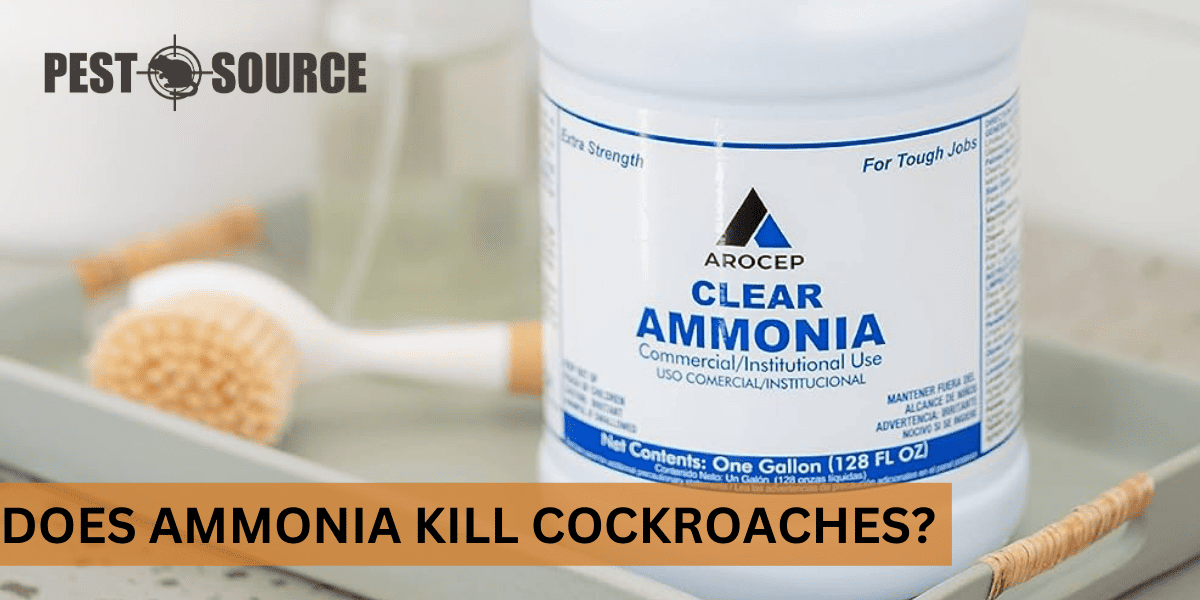Ammonia can kill cockroaches as it acts as a strong irritant to them. In this article, we’ll explore how to effectively use ammonia as a roach repellent and the safety precautions to consider.
POINTS
- Ammonia may kill cockroaches on direct contact, but it is not an effective long-term pest control solution and cockroaches tend to avoid areas treated with it, potentially relocating to untreated areas.
- Household cleaners like bleach and ammonia are not the most practical or safe pest control solutions, and their use can pose significant health risks and environmental concerns.
- Ammonia’s strong odor may act as a repellent, causing avoidance behaviors in cockroaches, but there is limited research supporting its effectiveness as a reliable repellent for long-term pest management.
- When using ammonia for pest control, it is crucial to dilute it, apply it in targeted areas, ensure proper ventilation, and take precautions to avoid harm to humans and pets.
- Alternative pest management practices, such as professional pest control services, natural repellents, and preventive measures, are generally safer and more effective than using ammonia or other household cleaners.
How Does Ammonia Affect Cockroaches?
Cockroaches are notorious for their resilience and adaptability, making them some of the most challenging pests to eliminate. One method that’s often discussed is the use of ammonia as an insecticide. Let’s delve into whether ammonia is effective in this battle against these persistent insects.
Chemical Properties of Ammonia and Its Impact on Cockroaches
Ammonia is a compound of nitrogen and hydrogen with the formula NH3. It is a common household cleaner with strong, pungent odors that are known to be irritating to both humans and pests. Its high pH level makes it a potent base, capable of disrupting cellular processes.
When it comes to cockroaches, ammonia’s strong odor and caustic nature suggest it could be harmful to them. In theory, the chemical can damage the exoskeleton of cockroaches and potentially kill them on contact. Additionally, it’s proposed that ammonia could penetrate the outer shell of cockroach eggs, hindering their development.
Scientific Studies on Ammonia’s Effectiveness Against Cockroaches
There isn’t a wealth of scientific literature specifically addressing the use of ammonia against cockroaches. However, from the available studies and expert opinions, the consensus is that while ammonia might kill cockroaches on direct contact, its effectiveness as a long-term solution is questionable. Cockroaches tend to avoid strong smells and may simply relocate to ammonia-free areas in your home.
Ammonia vs. Other Household Cleaners in Pest Control
Ammonia is not the only household cleaner repurposed for pest control. Let’s compare its efficacy with other common cleaners like bleach.
Efficacy of Ammonia Compared to Other Cleaners
- Bleach: Known for its disinfecting properties, bleach can also be fatal to cockroaches. However, like ammonia, it is only effective on direct contact and does not offer a long-lasting solution.
- Vinegar: While vinegar is less toxic, its efficacy against pests like cockroaches is minimal. It mainly serves as a cleaning agent that can deter pests due to its smell.
- Boric Acid: Unlike ammonia or bleach, boric acid is a pesticide that can effectively kill cockroaches. It acts as a stomach poison and has a residual effect.
Safety, Practicality, and Environmental Impact
Using ammonia or bleach for pest control poses safety risks due to their toxic and corrosive nature. They can be harmful to humans, pets, and the environment if not used with proper precautions. In contrast, boric acid, while still requiring careful handling, generally presents fewer risks when used as directed.
Scientific Evidence on Effectiveness and Risks
Scientific evidence suggests that while household cleaners can kill pests on contact, they are not the most effective or practical solutions for pest control. The risks associated with their use, including potential health hazards and environmental damage, often outweigh the benefits.
The Repellent Effect of Ammonia and Behavioral Responses of Roaches
Understanding how pests react to ammonia is crucial in assessing its potential as a repellent.
Does Ammonia Act as a Deterrent?
Ammonia’s strong odor is known to repel various pests, including cockroaches. They have a highly developed sense of smell and are likely to avoid areas treated with ammonia. However, this does not necessarily translate to an effective long-term pest control strategy, as roaches may simply find untreated areas to infest.
Behavioral Responses of Cockroaches to Ammonia
Cockroaches are likely to exhibit avoidance behaviors when confronted with the strong odor of ammonia. They may flee the area or become less active, but they are unlikely to be eradicated from the premises completely. The smell of ammonia may disrupt their normal foraging and hiding behaviors temporarily.
Research Supporting Ammonia as an Effective Repellent
Research on ammonia as a repellent is limited, but anecdotal evidence and preliminary studies suggest that while it may have some immediate repellent effects, it is not a reliable long-term solution for cockroach infestations.
Practical Guidelines for Using Ammonia in Pest Control
If you’re considering using ammonia to control a cockroach problem, it’s essential to do so with caution and knowledge. Here are some practical guidelines to help ensure that your use of ammonia is both safe and effective.
How to Use Ammonia Safely Against Cockroaches
- Dilution: Always dilute ammonia with water before use. A general guideline is to mix one part ammonia with one part water.
- Targeted Application: Apply the diluted ammonia solution to areas where cockroaches are frequently spotted, such as under sinks, behind appliances, and along baseboards.
- Avoid Direct Contact: Use gloves and avoid direct skin or eye contact with ammonia, as it can cause irritation or burns.
Strategic Applications of Ammonia
- Down the Drains: Pouring diluted ammonia down sinks and drains can help address cockroach infestations that originate from plumbing areas.
- Trash Bins: Cleaning trash bins with an ammonia solution can deter cockroaches from foraging for food in these areas.
Safety Precautions for Humans and Pets
- Ventilation: Ensure the area is well-ventilated when using ammonia to prevent the inhalation of fumes.
- Storage: Keep ammonia securely stored away from children and pets.
- No Mixing: Never mix ammonia with bleach or other cleaners, as this can produce toxic gases.
Alternative Pest Management Practices
While ammonia may have some short-term benefits, it’s not a comprehensive solution for pest control. Here are alternative methods that can be more effective and safer:
- Professional Pest Control: Hiring a pest control service can provide a more permanent solution to infestations.
- Natural Repellents: Using natural substances like diatomaceous earth or essential oils can be safer and still deter pests.
- Preventive Measures: Regular cleaning, sealing entry points, and proper food storage are key to preventing infestations.
Debunking Myths About Ammonia in Pest Control
There are many misconceptions surrounding the use of ammonia for pest control. Let’s clarify some of these myths and provide a fact-based perspective.
Common Beliefs and Misconceptions
- Myth: Ammonia can completely eradicate a cockroach infestation.
- Reality: Ammonia may kill some cockroaches on contact, but it is unlikely to eliminate an entire infestation.
Attractiveness or Repulsiveness of Ammonia to Cockroaches
- Myth: Cockroaches are attracted to the smell of ammonia.
- Reality: Cockroaches are generally repelled by the strong smell of ammonia.
Fact-Based Perspective on Ammonia in Pest Control
- Fact: Ammonia can be a temporary deterrent but is not a reliable or sustainable pest control method.
- Fact: The use of ammonia poses health risks and should be considered carefully before being used as a pest control strategy.



